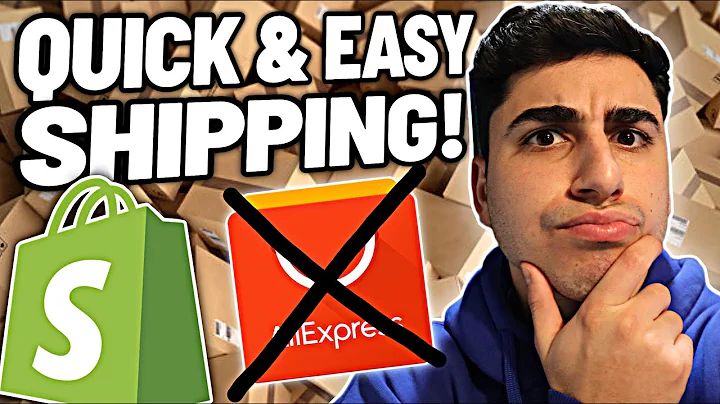Master the Art of Drop Shipping with our Webinar
Table of Contents:
- Introduction
- What is Drop Shipping?
- Why Engage in Drop Shipping?
- Requirements for a Successful Drop Ship Program
4.1 Agreements with Partners
4.2 Item Information and Exchange
4.3 Processes and Systems for Communication
4.4 Performance Tracking and Measurement
4.5 Engaging the Right Partners
- Implementing Drop Shipping
5.1 Do-It-Yourself
5.2 Outsourcing to a 3PL
5.3 Automation with Expert Help
- How ShipStation Facilitates dropship Logistics
- Survey Results and Insights
7.1 When Did Companies Start Drop Shipping?
7.2 Timeframe for First Drop Ship Order
7.3 Type of Retailers Initiating Drop Ship Orders
7.4 Percentage of Sales from Drop Shipping
7.5 Preparing for Drop Shipping
7.6 Triggers for Automating Fulfillment Operations
7.7 Strengthening Drop Shipping Capabilities
7.8 Best Investments for Drop Shipping Success
- Conclusion
Introduction
Drop shipping has become a popular business model in the ecommerce industry, allowing retailers to sell products without the need for inventory storage or shipping. In this article, we will discuss the fundamentals of drop shipping, its advantages, and the key elements required for a successful drop ship program. We will also explore different methods of implementing drop shipping, including do-it-yourself, outsourcing to a third-party logistics provider (3PL), or automation with expert help, such as ShipStation. Additionally, we will share insights from a survey conducted on companies engaged in drop shipping, highlighting their experiences and investments. So, whether you're new to drop shipping or looking to improve your existing program, this article will provide you with valuable information and actionable strategies to succeed in the drop shipping industry.
What is Drop Shipping?
Drop shipping is a business model in which products are sold by retailers without the need for inventory storage or shipping. Instead, the retailer partners with suppliers or manufacturers who handle the warehousing, packaging, and shipping of the products directly to the customers. This eliminates the need for the retailer to invest in inventory or manage the logistics of order fulfillment. Drop shipping allows retailers to focus on marketing, sales, and customer service, while relying on their partners to handle the operational aspects of order fulfillment.
Why Engage in Drop Shipping?
There are several reasons why retailers and suppliers choose to engage in drop shipping:
-
Increased Sales Potential: Drop shipping allows retailers to sell a wide range of products without the need for inventory. This expands their product offering and gives them access to a larger customer base, potentially leading to increased sales and revenue.
-
Cost Savings: By not holding inventory, retailers can save on costs associated with warehousing, inventory management, and shipping. This allows them to allocate resources to other areas of their business, such as marketing and customer service.
-
Flexibility and Scalability: Drop shipping offers a flexible business model that can be easily scaled as the demand grows. Retailers can add new products and partners without the need for additional resources or infrastructure.
-
Wider Selection: Drop shipping enables retailers to offer a larger assortment of products, often referred to as an "endless aisle." This gives customers access to a greater variety of products, increasing customer satisfaction and loyalty.
-
Enhanced Customer Experience: With drop shipping, retailers can provide a seamless and personalized customer experience. Products are shipped directly from the supplier, allowing for faster delivery times and consistent branding throughout the process.
Despite these benefits, drop shipping also comes with its challenges. Retailers must establish strong partnerships with suppliers, effectively manage inventory, and ensure smooth coordination of communication and order fulfillment. However, by addressing these challenges and leveraging automation tools like ShipStation, drop shipping can lead to long-term business success.
Requirements for a Successful Drop Ship Program
To build and maintain a successful drop ship program, several key elements need to be in place:
4.1 Agreements with Partners: Retailers and suppliers must have clear agreements in place that define their roles, responsibilities, and expectations. These agreements should cover areas such as pricing, shipping terms, branding guidelines, and return policies.
4.2 Item Information and Exchange: Accurate and complete item information is crucial for successful drop shipping. Retailers must ensure that the product descriptions, images, pricing, and other relevant details are provided to the suppliers in a standardized format. This facilitates efficient order processing and ensures a consistent customer experience.
4.3 Processes and Systems for Communication: Effective communication between retailers and suppliers is essential for seamless order fulfillment. Utilizing Electronic Data Interchange (EDI) or retailer portals can automate the exchange of information, including inventory updates, purchase orders, advanced shipping notices, packing slips, and invoices. This streamlines the communication process and reduces manual errors.
4.4 Performance Tracking and Measurement: Monitoring and measuring the performance of the drop ship program is vital for identifying areas of improvement. Key metrics to track include on-time shipping, order accuracy, customer satisfaction ratings, and returns processing time. By analyzing these metrics, retailers can identify bottlenecks, resolve issues, and optimize their drop ship operations.
4.5 Engaging the Right Partners: Choosing reliable suppliers, 3PL providers, and automation tools is crucial for the success of a drop ship program. Retailers should partner with suppliers who have the necessary inventory, capabilities, and commitment to meet their requirements. Similarly, selecting a trusted 3PL provider or automation tool like ShipStation can simplify the logistics and streamline the fulfillment process.
Implementing Drop Shipping
There are different approaches to implementing drop shipping, depending on the retailer's capabilities, resources, and business objectives:
5.1 Do-It-Yourself: Retailers can choose to handle all aspects of drop shipping in-house. This approach requires establishing direct partnerships with suppliers, implementing systems for inventory management, order processing, and shipping, as well as managing customer service and returns. While this approach offers full control and flexibility, it requires significant investments in infrastructure, technology, and workforce.
5.2 Outsourcing to a 3PL: Retailers can opt to outsource their drop shipping operations to a third-party logistics provider (3PL). A 3PL can handle inventory management, order processing, shipping, and even customer service and returns on behalf of the retailer. This allows retailers to focus on marketing and sales activities while relying on the expertise and infrastructure of the 3PL. However, retailers should carefully choose a reputable and reliable 3PL that aligns with their business objectives.
5.3 Automation with Expert Help: Retailers can leverage automation tools and platforms, such as ShipStation, to streamline their drop shipping operations. ShipStation offers features like order and inventory management, shipping label generation, branded tracking pages, and automation of notifications to customers and partners. By integrating with EDI systems and retail platforms, ShipStation enables seamless communication and data exchange, improving efficiency and scalability.
How ShipStation Facilitates Dropship Logistics
ShipStation is a web-based platform that aggregates ecommerce channels and simplifies order fulfillment. ShipStation can be utilized by drop shippers to manage and automate their fulfillment operations, regardless of the number of selling channels or retail partners they have. The platform offers features such as multi-channel integration, label printing, carrier selection, and automated notifications to customers.
ShipStation's automation engine allows drop shippers to process orders in bulk, reducing the time and effort required for fulfillment. Its branded tracking pages ensure a consistent and personalized customer experience, with notifications and tracking information aligned with the retailer's branding.
By integrating with EDI systems and retail platforms, ShipStation enables seamless communication and data exchange between drop shippers and their retail partners. This simplifies the order processing workflow, eliminates manual errors, and improves overall efficiency.
Survey Results and Insights
In a survey conducted on companies engaged in drop shipping, several insights were gathered:
7.1 When Did Companies Start Drop Shipping? Over 57% of the surveyed companies started drop shipping more than three years ago, highlighting the growing popularity and longevity of drop shipping as a business model.
7.2 Timeframe for First Drop Ship Order: Over 68% of the companies received their first drop ship order within a week of signing agreements with retailers, emphasizing the quick implementation and benefits of drop shipping.
7.3 Type of Retailers Initiating Drop Ship Orders: The survey showed that drop ship orders can come from a variety of retailers, including regional retailers and others outside the traditional online retail landscape. This indicates the wide range of opportunities for drop shippers to partner with different retail channels.
7.4 Percentage of Sales from Drop Shipping: Over half of the surveyed companies reported that over half of their sales came from drop shipping or direct-to-consumer orders. This highlights the significant impact drop shipping can have on a retailer's overall sales and revenue.
7.5 Preparing for Drop Shipping: While some companies had no preparation for drop shipping, many focused on building automation capabilities, deploying EDI, and securing additional resources such as warehouse space or staff. These investments in automation and infrastructure demonstrate the recognition of the value and potential of drop shipping.
7.6 Triggers for Automating Fulfillment Operations: Anticipated growth and complex requirements from retail partners were the primary triggers for companies to automate their fulfillment operations. This showcases the scalability and flexibility of drop shipping, as well as the need for efficient processes and systems to handle increased order volumes.
7.7 Strengthening Drop Shipping Capabilities: Improving inventory management and investing in EDI were the top priorities for companies looking to strengthen their drop shipping capabilities. These areas are crucial for ensuring accurate and up-to-date product information and streamlined communication with retail partners.
7.8 Best Investments for Drop Shipping Success: Investing in EDI was considered the best investment for drop shipping success, followed by improving inventory management. These investments align with the key elements for a successful drop ship program, emphasizing the importance of automation, data exchange, and inventory control.
Conclusion
Drop shipping offers retailers and suppliers numerous benefits, including increased sales potential, cost savings, flexibility, and enhanced customer experiences. By implementing a successful drop ship program and leveraging automation tools like ShipStation, retailers can streamline their operations, scale their business, and maximize their profitability. Through the insights provided by survey results, it is evident that drop shipping has become a key strategy for retailers and suppliers of all sizes. By understanding the requirements, challenges, and best practices of drop shipping, retailers can position themselves for success in the ecommerce industry. With the right partnerships, systems, and investments, drop shipping can provide a significant competitive advantage and drive long-term business growth.















